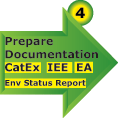Click on the diagram below to navigate.

Purpose of this step. Based on your screening results, determine the environmental documentation you must submit.
Brief explanation of each of the four basic environmental documents. Download links to necessary forms and annotated outlines.
Instructions. Use the table below to match your screening results from Step 2 against required environmental documentation. Your screening results should already be recorded in the SUMMARY TABLE you began in STEP 1.
Use the buttons within the table to access downloadable forms and a brief description of each type of documentation.
The next step will help you complete the required documentation.
IMPORTANT: If your screening identified "high risk" activities, you should consult the Mission Environmental Officer (MEO), Bureau Environmental Officer (BEO), or Regional Environmental Advisor (REA) now. Note:
| Overall screening outcome | Environmental Documentation Required | Notes |
|---|---|---|
| All activities are exempt | NONE | |
| All activities are categorically excluded | Categorical Exclusion Request Compliance Facesheet |
If an IEE finds that the project or activity may have a significant adverse effect on the environment, a full environmental assessment will be required |
| Some activities require an IEE, some are categorically exempt* | IEE that...
Compliance Facesheet |
|
| All activities require an IEE* | IEE covering all activities Compliance Facesheet |
|
| If you are preparing environmental documentation for an EXISTING TITLE II activity, learn more about the Environmental Status Report, | ||
| NOTE: There should be no instances in which a mix of exempt and non-exempt activities are submitted in a single proposal. | ||
*if some activities are high-risk, consult the MEO, BEO or REA now. * For "high-risk" actions, Reg 216 permits the preparation of an Environmental Assessment (EA), the fullest form of environmental review, without first preparing an IEE, which is a far shorter & simpler document. However, this tool follows recommended practice in directing that an IEE be prepared even for high-risk activities. The reasons for this are discussed in Step 4. |
||
